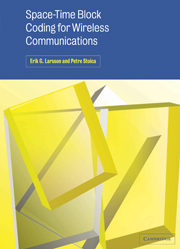Book contents
- Frontmatter
- Contents
- ABOUT THE AUTHORS
- PREFACE
- NOTATION
- COMMONLY USED SYMBOLS
- ABBREVIATIONS
- 1 INTRODUCTION
- 2 THE TIME-INVARIANT LINEAR MIMO CHANNEL
- 3 MIMO INFORMATION THEORY
- 4 ERROR PROBABILITY ANALYSIS
- 5 RECEIVE DIVERSITY
- 6 TRANSMIT DIVERSITY AND SPACE-TIME CODING
- 7 LINEAR STBC FOR FLAT FADING CHANNELS
- 8 LINEAR STBC FOR FREQUENCY-SELECTIVE CHANNELS
- 9 COHERENT AND NON-COHERENT RECEIVERS
- 10 SPACE-TIME CODING FOR INFORMED TRANSMITTERS
- 11 SPACE-TIME CODING IN A MULTIUSER ENVIRONMENT
- A SELECTED MATHEMATICAL BACKGROUND MATERIAL
- B THE THEORY OF AMICABLE ORTHOGONAL DESIGNS
- REFERENCES
- INDEX
1 - INTRODUCTION
Published online by Cambridge University Press: 31 October 2009
- Frontmatter
- Contents
- ABOUT THE AUTHORS
- PREFACE
- NOTATION
- COMMONLY USED SYMBOLS
- ABBREVIATIONS
- 1 INTRODUCTION
- 2 THE TIME-INVARIANT LINEAR MIMO CHANNEL
- 3 MIMO INFORMATION THEORY
- 4 ERROR PROBABILITY ANALYSIS
- 5 RECEIVE DIVERSITY
- 6 TRANSMIT DIVERSITY AND SPACE-TIME CODING
- 7 LINEAR STBC FOR FLAT FADING CHANNELS
- 8 LINEAR STBC FOR FREQUENCY-SELECTIVE CHANNELS
- 9 COHERENT AND NON-COHERENT RECEIVERS
- 10 SPACE-TIME CODING FOR INFORMED TRANSMITTERS
- 11 SPACE-TIME CODING IN A MULTIUSER ENVIRONMENT
- A SELECTED MATHEMATICAL BACKGROUND MATERIAL
- B THE THEORY OF AMICABLE ORTHOGONAL DESIGNS
- REFERENCES
- INDEX
Summary
The demand for capacity in cellular and wireless local area networks has grown in a literally explosive manner during the last decade. In particular, the need for wireless Internet access and multimedia applications require an increase in information throughput with orders of magnitude compared to the data rates made available by today's technology. One major technological breakthrough that will make this increase in data rate possible is the use of multiple antennas at the transmitters and receivers in the system. A system with multiple transmit and receive antennas is often called a multiple-input multiple-output (MIMO) system. The feasibility of implementing MIMO systems and the associated signal processing algorithms is enabled by the corresponding increase of computational power of integrated circuits, which is generally believed to grow with time in an exponential fashion.
Why Space-Time Diversity?
Depending on the surrounding environment, a transmitted radio signal usually propagates through several different paths before it reaches the receiver antenna. This phenomenon is often referred to as multipath propagation. The radio signal received by the receiver antenna consists of the superposition of the various multipaths. If there is no line-of-sight between the transmitter and the receiver, the attenuation coefficients corresponding to different paths are often assumed to be independent and identically distributed, in which case the central limit theorem [papoulis, 2002, ch. 7] applies and the resulting path gain can be modelled as a complex Gaussian random variable (which has a uniformly distributed phase and a Rayleigh distributed magnitude).
- Type
- Chapter
- Information
- Publisher: Cambridge University PressPrint publication year: 2003
- 6
- Cited by



